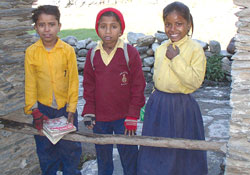 On our last morning in Bajhang, a man walked up and asked me to see his son. Kiran was a seven-year-old and his father had carried him eight hours down from the hills.
On our last morning in Bajhang, a man walked up and asked me to see his son. Kiran was a seven-year-old and his father had carried him eight hours down from the hills.
The boy had two weeks of fever and a tender bulge on the left side of his neck. The father showed me a paper from Chainpur Hospital written the day before: 'Refer to higher centre for treatment'.
In fact, all the boy had was a skin abscess and he just needed minor surgery. Unfortunately, no anesthesia or pain relief medicine was available. The incision into his neck, though successful, was very painful. He had to be held down, his crying filling the hallway. As we were cleaning up, we watched the grateful father laying his son on the porch outside the hospital to warm him in the winter sun.
In towns and villages across Nepal, scenes like these play out every day. There is a hospital building and some staff, but they cannot provide even basic care. Women giving birth, children with broken arms and legs, people with burns, fever, and pain, all crying out for change in Nepal's health care system.
Nepal's health officials work against huge obstacles to provide comprehensive health care in remote places with a limited budget, and in the face of political turmoil. While the health infrastructure is generally adequate the big problem is assuring that staff are on duty, have competent skills, and are caring.
Only 18 percent of Nepali women who deliver babies have a trained health worker in attendance, and for the poorest parts of the country it is less than five percent. Every day 12 Nepali women die at childbirth.
In the last ten years Nepal has seen tremendous growth in medical colleges and the annual production of new doctors will soon cross 1,000. We now have over 40 nursing campuses. Each year, the 125 separate medical institutes under CTEVT produce over 4,000 new health assistants, nurse midwives, and community medical assistants. Where do they all go? Why are rural Nepalis still without health care?
We need a paradigm shift in our thinking about health care in Nepal in three fundamental areas:
1 Provide quality care to the greatest number
Are we aiming for highest quality care for a few or quality care for many? The Health Ministry is now creating posts for health care workers who can cover much wider areas of the country. For example, while a specialist anesthesia doctor is unlikely to ever venture into the hospitals of Panchtar, Baglung or Dandheldura there are now Anesthesia Assistants in each of those places, enabling operations to be conducted. Similarly, the SBA (skilled birth attendant) program trains not just doctors but multiple levels of health workers, nurses and ANMs to conduct safe deliveries.
2 Support health care workers in the field
Why do doctors, nurses and mid-level health workers refuse to stay in rural hospitals? First, there is a strong pull to migrate. In one of Nepal's premier medical colleges last year, over half of its graduating class of doctors left to train in the United States. Of them, 95 percent of will not return. In the past five years nurses have joined doctors in this mighty exodus. And who can blame them? A staff nurse will earn 10 times more in England than in Nepal.
Those who stay need to be taken care of while they work in difficult circumstances. Increasingly, local committees are starting to manage rural hospitals, sometimes with excellent results. Several factors help in keeping health workers happy and productive. These are the 5 C's:
. Communication: Enable the hospital to use the internet, including telemedicine facility.
. Continuing Medical Education: Provide professional nourishment for staff growth.
. Connection with a higher hospital: Create a link with staff in another, regional center.
. Community management: Hospital staff do better when they are managed locally.
. Children's education: Unless their kids are looked after, the staff will soon move away.
There is no shortage of health care workers in Nepal, the problem is persuading them to stay where they are needed the most.
3 Build beyond MBBS
I am a doctor, and I have trained young doctors in Nepal for the last 20 years. Doctors are certainly needed in Nepal but they are not a remedy to all of our problems. In medicine experience sometimes counts even more than fine training. I know of experienced health assistants who can diagnose a patient better than most new doctors. And ANMs are far more skillful at delivering babies.
The captain of the rural health care team should be an MD General Practice doctor. Across Nepal, we have seen these all-rounders transform local health care systems. An MDGP can do operations, deliver babies, take care of kids and adults and has administrative training. We must train more MDGPs and get 2-3 of them to work in each district hospital as a team.
Let's re-examine our guiding principles, test them against available evidence and build on this strong foundation. Only then will we begin to hear less crying in the countryside.
Dr Mark Zimmerman is Executive Director of the Nick Simons Institute, which is working to enhance health care in rural Nepal.



